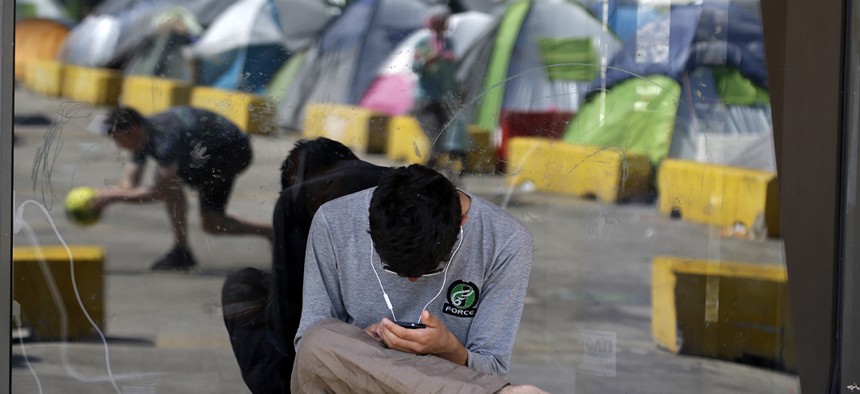Mobile Innovation Will Help 2 Billion More People Get Access to Health Care and Education

A migrant checks his cell phone as tents are reflected on a building window at the Athens port of Piraeus, Thursday, April 28, 2016. Thanassis Stavrakis/AP
For low-income consumers in emerging markets, the full potential of mobile financial services is yet to be unlocked, a new report suggests.
From music to movies, from banking to buying food, mobile phones have revolutionized the way we access the world today. But for low-income consumers in emerging markets, the full potential of mobile financial services is yet to be unlocked, a new report suggests.
Despite the growth in smartphone adoption and mobile payment systems in many countries, telecom operators and regulators were yet to invest in products and distribution models that would cater for largely underserved or unbanked consumers. The report from Swedish insurance technology company BIMA surveyed 4,000 low-income respondents in 10 countries across Africa, Asia and Latin America. BIMA notes the lack of synergy between regulators and operators in emerging markets has also undermined the development of mobile solutions for complex services such as health care, insurance and savings.
In emerging markets, formal banking reaches about 37 percent of the population, compared with a 50 percent penetration rate for mobile phones financial systems, according to global management consultancy McKinsey. This constitutes 2.2 billion adults who don’t use banks or micro-financial institutions in the world—more than 326 million of whom live in Sub-Saharan Africa. If companies are able to successfully tap into these unbanked consumers, that will constitute a “second wave” of mobile financial services, where customers move beyond using mobile as a channel for just payments.
Examples of these innovations are slowly proliferating across emerging markets, especially in the African continent. For instance, more telecom operators are allowing third-party start-ups to use their platforms as the main payment options. In Kenya, Safaricom opened up M-Pesa, the world’s leading mobile transfer system so innovators could develop systems for customers to pay for electricity, get clean water, hail cabs and even deliver food to refugees.
In South Africa, Hello Doctor, a mobile-based Q&A service with registered doctors, allows patients to pay for a monthly service through their MTN or Vodacom airtime. In Kenya, Sendy, an iOS/Android app, now uses the M-Pesa platform to do door-to-door package delivery all day, every day.
In the micro-insurance industry, BIMA’s partnership with Millicom telecom’s Tigo cash services has also seen the registration of 2.7 million people in Ghana, Tanzania and Senegal since the project started in 2010. Tigo’s success with insurance products—mainly related to life, hospitalization and personal accidents—show there’s an appetite to pay for financial products in emerging countries.
However, telecom companies will have to embrace innovative practices in order to drive inclusion and reach these untapped markets. These solutions could include conducting education or awareness campaigns, working with different regulators, introducing electronic signatures to allow unbanked people to sign up remotely, besides providing customers with multiple payment options like airtime, mobile money or post-paid billing services.
The end result would only be a win-win for everyone in the emerging markets, where consumption is expected to reach $30 trillion by 2025 according to McKinsey. These new innovations will boost the economy, increasing government revenue and most of all, bring those in the bottom pyramid into the financial fold.


